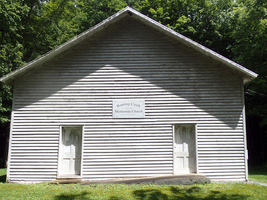 | Back to e-WV
| Back to e-WV
 The West Virginia Encyclopedia
The West Virginia Encyclopedia
 | Back to e-WV
| Back to e-WV
 The West Virginia Encyclopedia
The West Virginia Encyclopedia

The first Mennonites in present West Virginia settled near Lewisburg in 1788 when preacher Isaac Kauffman (Coffman), his wife, and eight children moved from Page County, Virginia. While no congregation was established, the Greenbrier Mennonites likely held religious meetings in their homes, a common practice among Virginia Mennonites of that time.
The roots of the Mennonite Church lay in the Anabaptist movement arising in Zurich, Switzerland, in the 16th century. Anabaptists believed in baptizing only adults old enough to decide religious matters for themselves; that church and state should be separate; and that individuals should be free to live and worship according to conscience. Stressing literal obedience to Christ’s commandments, Anabaptists refused to swear oaths or go to war. In 1536, a former Catholic priest by the name of Menno Simons joined the movement. Due to his influential leadership, Anabaptists were commonly called Menists or Mennonists, and later, Mennonites.
Persecution and economic hardship in Europe spurred immigration to North America. Mennonites first came to Pennsylvania in 1683, gradually spreading south into the Shenandoah Valley of Virginia.
In the late 1850s, two Mennonite ministers from the Shenandoah Valley made preaching forays across the mountain to the west. During the Civil War, Potter John Heatwole lived in the Seneca Rocks area. He was one of several Mennonites who took refuge in the mountains to avoid being forced to fight in the war. After the Civil War, Mennonite circuit riders expanded their preaching trips into Pendleton, Randolph, Tucker, and Hardy counties.
Around 1884, Mennonites erected their first meeting house in West Virginia in Pendleton County near Seneca Rocks. In 1913, the building was moved to Roaring Creek and reassembled. While it no longer hosts services, it still stands and is known as the Roaring Mennonite Church. About 1890, a meeting house was built near Lost River in Hardy County. In the late 1800s and early 1900s, additional congregations were established in the areas covered by the circuit riders, some in dedicated churches and others gathering in schoolhouses. Resident leaders replaced the circuit riders.
During World War I, Mennonites across the nation became targets of government prosecution due to their opposition to the war on religious grounds. One of the few cases that actually went to trial was that of Rhine Benner, leader of a Mennonite congregation in Job, Randolph County. On the written advice of his bishop, Lewis J. Heatwole, Benner guided his flock not to purchase war bonds. District Attorney Stuart W. Walker of Martinsburg prosecuted Benner and Heatwole for violating the Sedition Act of 1918. Both pleaded guilty and were fined $1,000.
As the 20th century progressed, the Mennonite mosaic in West Virginia became quite diverse. New congregations started in Pocahontas (1959), Monroe (1976), Barbour (1982), Hampshire (2000), and Greenbrier (2003) counties. Congregations are affiliated with various branches of the Mennonite Church, including Beachy Amish Mennonite Church, Mennonite Christian Fellowship, the Allegheny and Virginia conferences of the Mennonite Church USA, Mountain Valley Mennonite Churches, and Southeastern Mennonite Conference. In 2023, there were approximately 20 small Mennonite congregations in West Virginia.
Some Mennonites continue to practice plain ways of dressing, living, and worship while others have adapted to the general surrounding culture. Probably most in West Virginia are of the more traditional type as regards dress but are fairly modern in the use of technology. Few if any forgo the use of automobiles and electricity.
Written by John R. Swartz
Brunk, Harry A. History of the Mennonites in Virginia, 1727-1900. Staunton: McClure Printing, 1959.
Brunk, Harry A. History of the Mennonites in Virginia 1900-1960. Verona: McClure Printing, 1972.
Eberle, Donald Charles. "Conscription Policy, Citizenship and Religious Conscientious Objectors in the United States and Canada during World War One." Ph.D. dissertation, Bowling Green State University, August 2013.